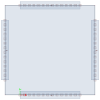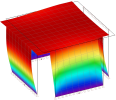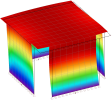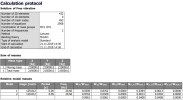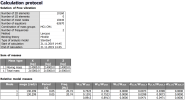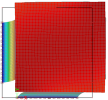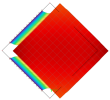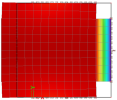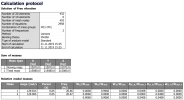Issue: mesh settings affect mode shapes - bi-symmetrical structures
Issue
- different mesh settings give completely different mode shapes
- although the structure is symmetrical and oriented according to GCS axes, the fundamental modes shapes are not exactly aligned with GCS - there are slight deviations
- although the structure is symmetrical and oriented according to GCS axes, there are non-zero results in the direction perpendicular to seismic action in the seismic calculation protocol
Meaning
Modal behaviour
Structures with double symmetry and identical properties in X and Y directions (see picture) are very sensitive for eigenvalue calculation.
In theory, the first 2 modes of such a structure are identical (same frequency and shape), except for a 90° rotation around the vertical axis.
When the analysis model is perfectly symmetrical, there is no way to know for sure, which of the two will come first during the numerical resolution of the eigenvalue problem. Very small, low-level variations may sway the solution one way or the other.
The mesh size can be a parameter that affects it. In this particular case, the results are - apparently - very different:
On left-hand side, results with a mesh of 0.5m; on the right-hand side, with a mesh of 0.1m.
The modal mass ratios show, that there are slight deviations perpendicularly to the main directions. It is also visible in the mode shape:
The picture shows mode shape 1, on the left-hand side with a mesh of 0.5m. The main displacement is in direction Y, but there is also a small deviation in direction X.
On the right-hand side, with a mesh of 0.1m, the main displacement is in direction X, with a more pronounced deviation in direction Y.
The difference of deviation is also visible in modal mass ratio values: the cumulated value is similar, but the distribution of individual modal values is different:
| Modal mass ratios for mesh 0.5m | |||
| Mode | Freq. [Hz] | Wxi/Wxtot | Wyi/Wytot |
| 1 | 20.66 | 0.03 | 0.8762 |
| 2 | 20.66 | 0.8762 | 0.03 |
| 0.9061 | 0.9061 | ||
| Modal mass ratios for mesh 0.1m | |||
| Mode | Freq. [Hz] | Wxi/Wxtot | Wyi/Wytot |
| 1 | 20.74 | 0.7523 | 0.1391 |
| 2 | 20.74 | 0.1391 | 0.7523 |
| 0.8913 | 0.8913 | ||
It is typical in such a structure, that the orientation of the modes can be totally arbitrary. However, they always come in pairs, with a 90° rotation.
For instance, when rotating entire model by 45°, the first mode shape has the exact same frequency as in the model above with the same mesh size, but it looks like this:
Introducing a very small imperfection in the model can help "cleaning up" the behaviour. For instance, changing the thickness of the two walls in X direction from 500 to 501mm leads to the following results (mesh 0.5m):
Both modes are perfectly aligned with GCS axes and modal values are exactly zero in the secondary direction for each mode.
Seismic results
Deviations, even small, in mode shapes can cause significant transverse effect in the seismic response of the structure for individual modes.
Considering again the example above, with mesh 0.5m, here is the seismic calculation protocol for seismic load cases BG5 (direction X) and BG6 (direction Y).
For direction X (BG5), the predominant mode is clear mode 2, with a value of Fx that represents ~96% of the total base shear in that direction.
The value of Fy, however, is far from negligible when looking at individual modes. CQC modal superposition cancels that discrepancy by taking into account the 2nd mode.
In this case, because of the slight deviation of the mode shapes, it would be wrong to consider only mode 2 for seismic action X.
It is also essential to use CQC modal superposition, because modes 1 and 2 have the exact same frequency, which leads to a correlation factor equal to 1. Using SRSS superposition would lead to totally different values.
Solution
Avoid perfectly bi-symmetrical models when possible.
Such models are anyway academic. Real structure always have some kind of imperfection.

